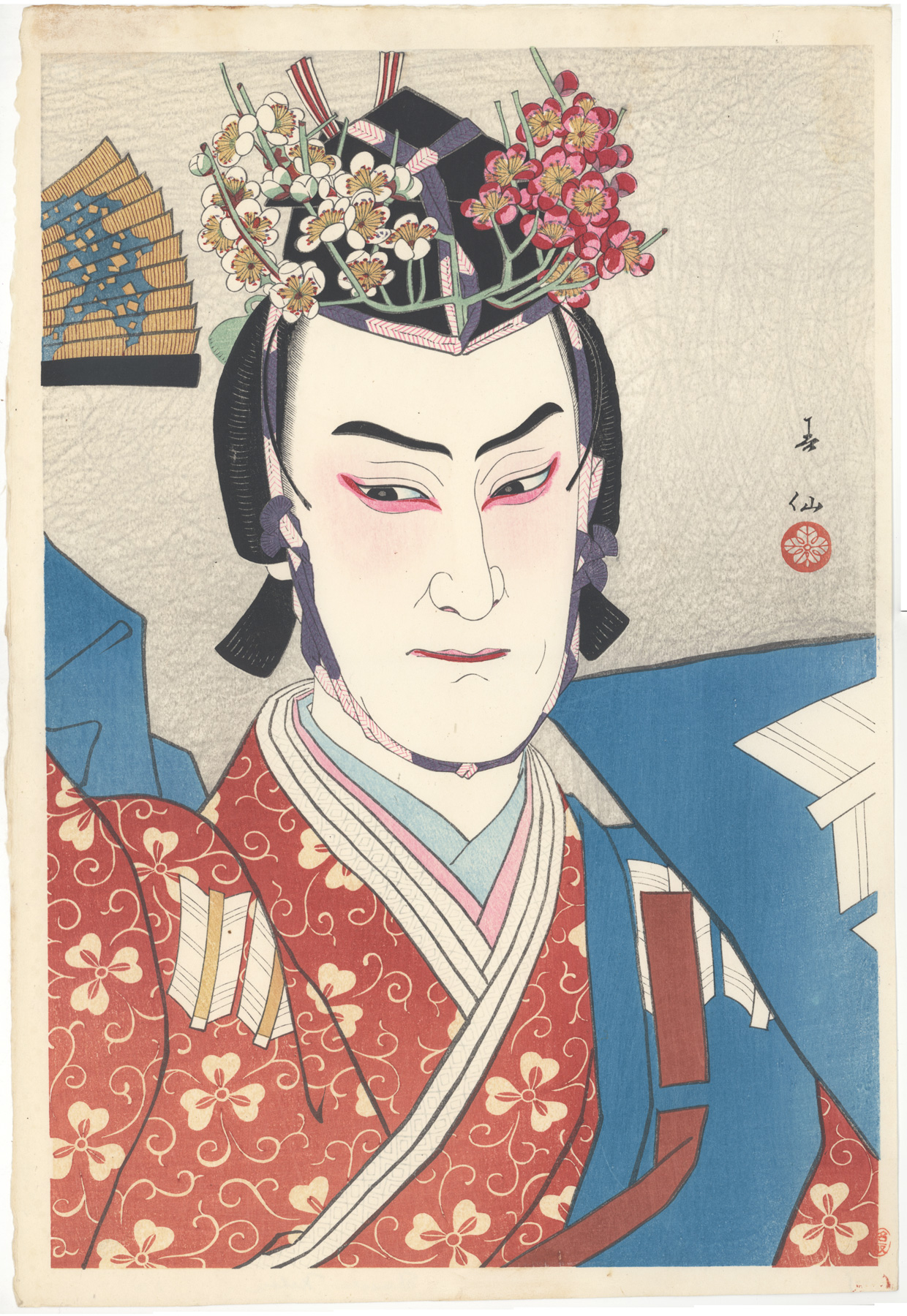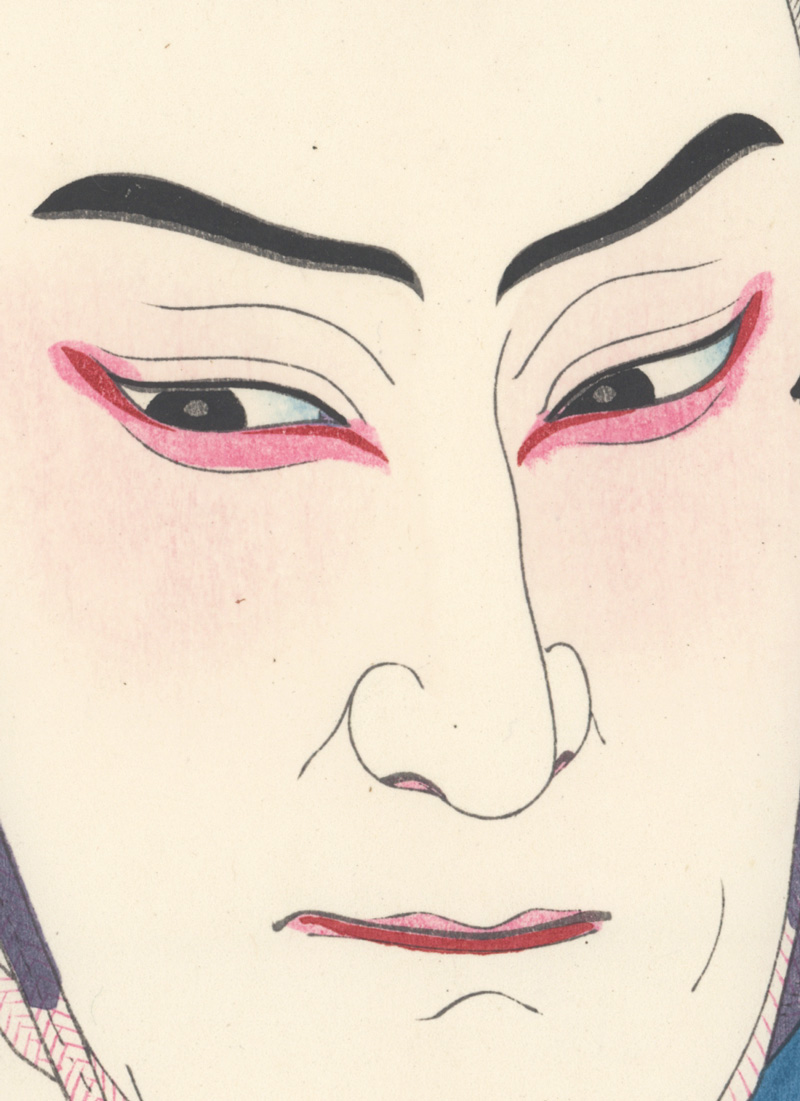About This Print
One of thirty-six prints making up the Watanabe-published series Collection of Creative Print Portraits by Shunsen (1925-1929). This print is the series installment no.28. Along with the print Ichikawa Sanshō in the role of Soga Gorō in the Play Uirō, one of two prints from this series in this collection.
The result of the [Watanabe-Shunsen] collaboration was a series called Shunsen nigao shū [Collection of Portraits by Shunsen], sometimes translated as Portraits of Actors in Various Roles, produced between 1925 and 1929. Watanabe’s artisans were at this time at the peak of their skills, producing blocks with pristine, clear lines, and inking them in brilliant colors that reflect the evolution of tonalities to a modern vibrancy. They were issued in a special paper folder, listing the names of the actors and their roles. The series was extended by 15 more prints between 1929 and 1934.
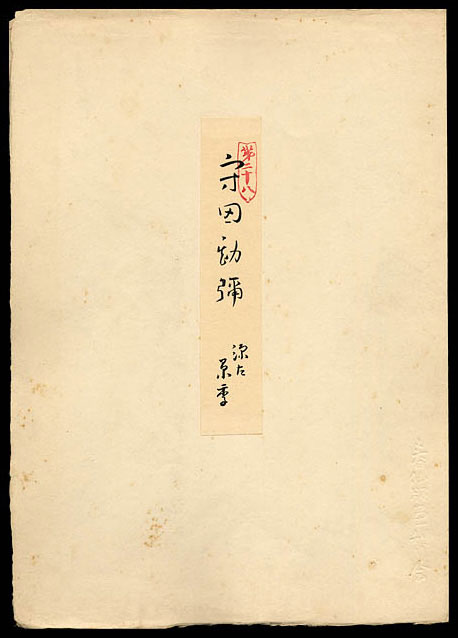 | 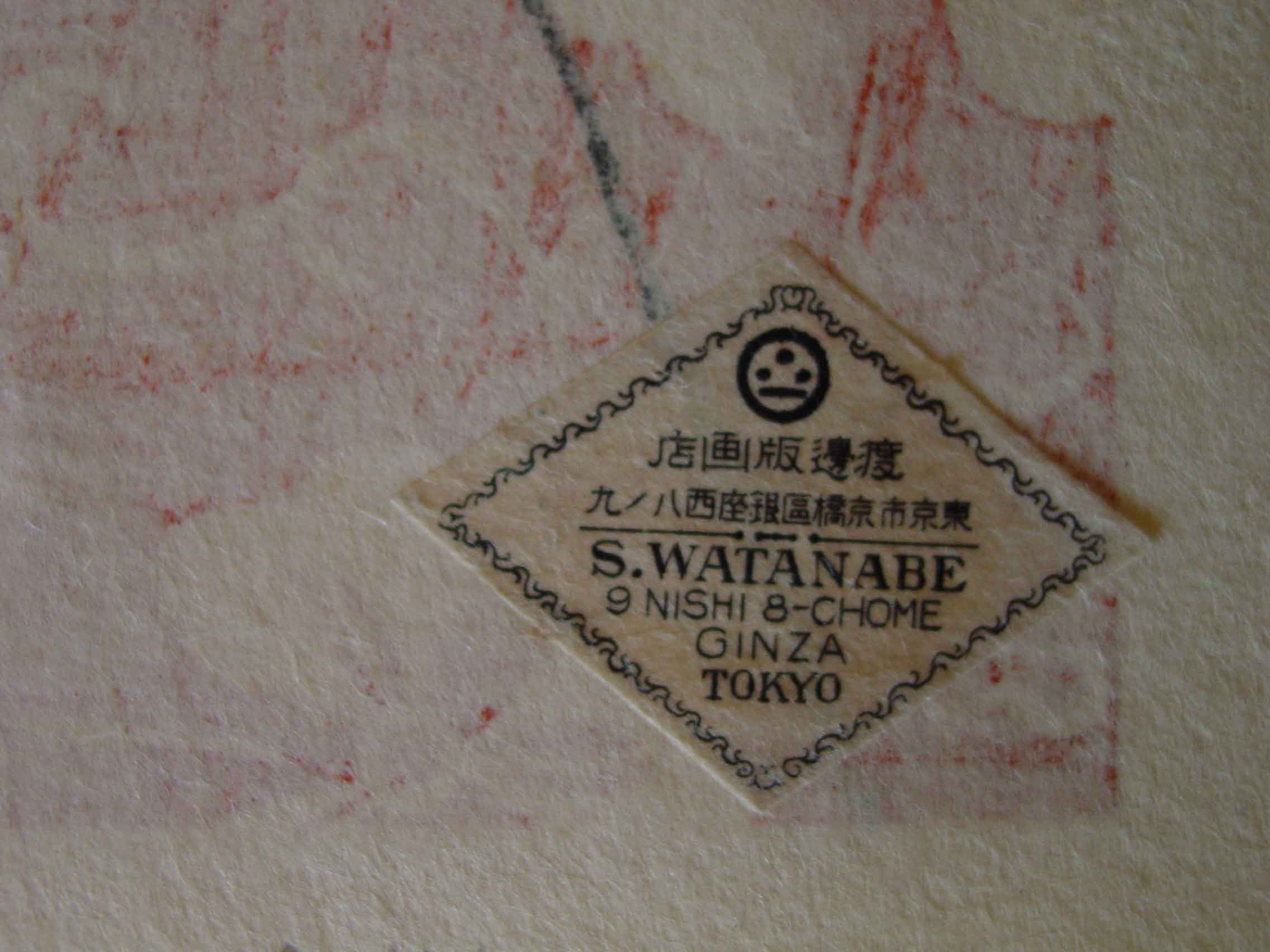 |
Catalogue Entry from The Toledo Art Museum Show 1930
One of thirty-six prints by Shunsen that were shown in the first shin hanga exhibition at the Toledo Museum of Art in 1930.
Actor in red orange kimono, flower and scroll pattern in yellow; crest, two white and yellow arrow-feathers; folded white collar with light gray fretwork design; two under-kimono, one pink, one light blue-green; blue shoulder capes with double arrow crest. Fan, black, yellow, and blue; headdress, light red and white plum blossoms, yellow centers; black hat tied with purple and white, red-lined cord. Background mottled gray.
Signed “Shunsen”; also his seal. Margin: “Natori”, artist’s stamp of approval. Edition, 150 impressions; issued in 1928. 14 15/16 x 10 1/32.
The Actor in the Print: Morita Kanya XIII
Source: Crosscurrents in the Drama: East and West Vol. 6, Stanley Vincent Longman; University of Alabama Press, 1998.Morita Kanya XIII (1885–1932), whose father had built the Shintomi-za, was eager to bring kabuki into the 20th century. Among his activities, he organized the Literary Arts Theatre (Bungei-za) which became active in 1915. He gathered around him young reform-minded kabuki actors, such as Otani Tomoemon VI (1886–1923) and Ichikawa Ennosuke II. They joined together with actresses trained at the Imperial Theatre’s acting school to study the new modern drama of the West. Kanya’s troupe of kabuki actors and modern actresses mounted 10 productions of new plays and of translated Western drama through 1925. Kanya played Jean Valjean in Hugo’s Les Miserables in 1920 at the Y¢raku-za and Bluntschli in Shaw’s Arms and the Man (Buki to Hito) at the Imperial Theatre in 1922 (Waseda 1998:245– 47). Kanya acted in Romeo and Juliet, the group’s production, in 1918 and played a highly acclaimed Hamlet in the group’s fourth production in 1919, using Shoyø’s direct translation in each case. Typical of Kanya’s troupe, he, a 13th-generation kabuki theatre manager and actor, acted opposite a newly trained shingeki actress, Otowa Kaneko, playing Ophelia (Sanshain Gekijø 1993:4).
The hereditary zamoto and actor Morita Kanya XII (1846–1897) opened the first modern kabuki theatre near the foreign settlement in Tsukiji in 1872. Named the Shintomi-za because it was in Shintomi-cho district, it offered chairs for Western visitors and introduced first gas and then electricity for stage lighting.
Kanya produced kabuki programs at night from five in the afternoon until eleven in the evening in the Western manner (daytime performance had been mandatory during the Tokugawa period). Kanya’s modernizing and Westernizing strategies included staging plays that would appeal to foreign residents and visiting dignitaries. The Shintomi-za quickly became the theatre of choice for Meiji-period elite and foreign spectators.
The Play and Character in the Print: Genta Kagesue in Genta Kando
Source: Aio Gallery website http://www.aoigallery.com/Natori_Shunsen_p4.html1. Genta Kagesue is ordered by his father to commit seppuku in the play Genta Kando.
2. Genta’s father believes that his son has disgraced the family name because he failed to be the first to attack the enemy in battle, but in reality, Genta intentionally deferred the honor to another warrior who had helped his father in the past.
3. Genta’s mother understands this and manages to convince his son to spare his own life and to regain his honor by returning to the battlefield.
Catalogue Raisonné Entry
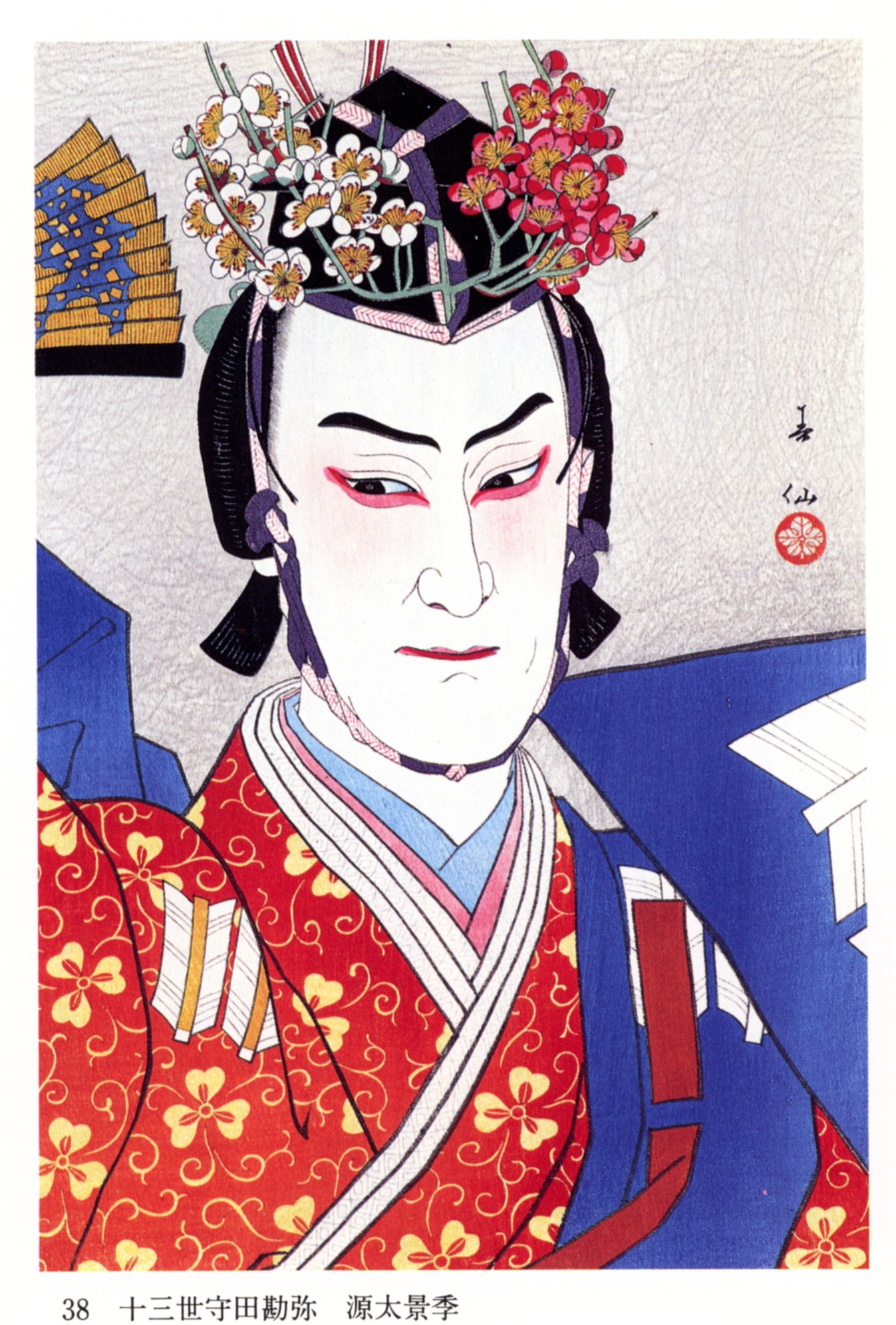 Kushigata Municipal Shunsen Museum Kushigata, Japan; 1991, p.46, pl. 38. |
Print Details
| IHL Catalog | #75 |
| Title | Morita Kanya XIII as Genta Kagesue |
| Series | 創作版画 春仙似顔集 (Sosaku hanga Shunsen nigao shū) Collection of Creative Print Portraits by Shunsen [Variously translated as Thirty-six Kabuki Actors Portraits or Portraits of Actors in Various Roles or Collection of Creative Portraits by Shunsen] |
| Artist | Natori Shunsen (1886 - 1960) |
| Signature |  |
| Seal |  |
| Date | 1928 |
| Edition | First and only edition of 150 prints |
| Publisher | Watanabe Shozaboru |
| Impression | excellent |
| Colors | excellent |
| Condition | good- overall light toning with minor remnants of paper cement stains topmargin and center of bottom margin which are more noticeable verso. This print underwent professional conservation (see "Conservation" below.) |
| Miscellaneous | |
| Genre | shin hanga (new prints); nigao-e |
| Format | Oban tate-e |
| H x W Paper | 16.0 x 10.75 in. (40.6 x 27.3 cm) |
| H x W Image | 14.9 x 10.0 in. (37.8 x 25.4 cm) |
| Collections This Print | National Gallery of Australia Accn No: NGA 98.160; The Tsubouchi Memorial Theatre Museum of Waseda University 201-0279; Toledo Museum of Art 1939.239 |
| Reference Literature | Catalogue Raisonne – Ukiyoe Kabuki Gi Han Ga: Shunsen Natori (TheSkill of Natori Shunsen in Kabuki Prints), Kushigata Municipal ShunsenMuseum, Kushigata, Japan, 1991, p. 46 number 38; Dramatic Impressions: Japanese Theatre Prints from the Gilbert LuberCollection, Chance, Frank L. & Davis, Julie Nelson, University ofPennsylvania Press, 2007; Modern Japanese Prints, Dorothy Blair, The Toledo Art Museum, 1997; Printed to Perfection: Twentieth-century Japanese Prints from theRobert O. Muller Collection, Merviss, Newland, et. al., HoteiPublishing, 2004 Strong Women, Beautiful Men: Japanese Portrait Prints from the Toledo Museum of Art, Laura J. Mueller, Toledo Museum of Art, 2005, p. 92; Fresh Impressions: Early Modern Japanese Prints, Carol M. Putney, et. al., Toledo Museum of Art, 2014, p. 197, pl. 161; Stars of the Tokyo Stage, Lucie Folan, et. al., National Gallery of Australia, 2012, p. 109. |
Conservation
Thisprint was conserved by the Portland Art Museum’s conservator ElizabethChambers in order to remove the discoloration from the front top marginof the print. Her report stated, “The stains on the Shunsen testpositive for removal with methyl ethyl ketone, suggesting rubber cementresidue as I suspected. The printing inks do not react to the solvent.The treatment for the Shunsen went well.”Before conservation.
After conservation.


